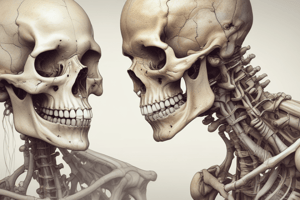Podcast
Questions and Answers
What type of cells are responsible for laying down unmineralized bone matrix during intramembranous osteogenesis?
What type of cells are responsible for laying down unmineralized bone matrix during intramembranous osteogenesis?
- Osteoblasts (correct)
- Chondrocytes
- Osteoclasts
- Osteocytes
During which stage of endochondral osteogenesis does the primary center of ossification begin?
During which stage of endochondral osteogenesis does the primary center of ossification begin?
- In the epiphyseal cartilage
- In the articular cartilage
- In the center of the cartilaginous model (correct)
- In the periosteal membrane
What role does alkaline phosphatase play in bone formation?
What role does alkaline phosphatase play in bone formation?
- It forms a protective layer around growing bones.
- It breaks down bone tissue.
- It induces the formation of hyaline cartilage.
- It aids in the mineralization of osteoid. (correct)
Which bones primarily develop through the intramembranous ossification method?
Which bones primarily develop through the intramembranous ossification method?
What remains between the bony diaphysis and epiphysis in endochondral bones, allowing for growth?
What remains between the bony diaphysis and epiphysis in endochondral bones, allowing for growth?
Flashcards are hidden until you start studying
Study Notes
Intramembranous Osteogenesis
- Bone formation directly from mesenchymal tissue, called mesenchyme, which forms membranes.
- Osteoblasts, bone-forming cells, lay down unmineralized bone matrix called osteoid.
- Osteoid quickly mineralizes due to the deposition of calcium phosphate crystals.
- Mineralization is facilitated by the enzyme alkaline phosphatase, secreted by osteoblasts.
- This method produces membrane bones, like flat skull bones, facial bones, and the clavicle.
Intracartilaginous (Endochondral) Osteogenesis
- A miniature cartilaginous model of the bone is formed first.
- Primary center of ossification develops in the center of the cartilaginous model.
- Secondary centers of ossification appear later in the bone ends, not simultaneously.
- Hyaline cartilage is not converted to bone; it is replaced by osseous tissue.
Bone Growth and Remodelling
- Bone formation is incomplete at birth.
- Intramembranous bones have remaining membrane for growth.
- Endochondral bones retain some cartilage, including the epiphyseal cartilage (growth plate) between the diaphysis and epiphysis of long bones.
- Cartilage at bone ends allows for lengthening during childhood and early adulthood.
- Bone also grows in diameter due to osteoblasts in the periosteum.
- Bone tissue is removed from the medullary cavity by osteoclasts to accommodate diameter growth.
- Closure of the epiphysis occurs during adulthood when the epiphyseal cartilage stops growing and fuses with the diaphysis.
Rule of Ossification
- Long bones ossify according to a rule: the epiphysis with the first-appearing secondary center of ossification fuses with the diaphysis last.
- This epiphysis is the growing end.
- Nutrient foramina are directed away from the growing end.
- For example, the humerus's nutrient foramen runs downwards, the radius and ulna's run upwards, the femur's runs upwards, and the tibia's runs downwards.
- This can be remembered with the anatomical proverb: "from the knee I flee, toward the elbow, I go."
- The fibula is an exception to this rule.
Types of Epiphyses
- Four types of epiphyses exist: pressure, traction, atavistic, and aberrant.
Pressure Epiphyses
- Located at bone ends transmitting body weight or under pressure during movement.
- They are articular and form part of joints.
- Examples: head of the femur and humerus.
Traction Epiphyses
- Non-articular and don't form joints.
- Provide attachment sites for tendons and ligaments.
- Ossify later than pressure epiphyses.
- Examples: greater and lesser trochanters of the femur, greater and lesser tubercles of the humerus.
Atavistic Epiphyses
- These represent bones that were once independent in animals but fused in humans.
- Example: the coracoid process of the scapula.
Aberrant Epiphyses
- Deviations from the normal and not always present.
- Examples: the head of the first metacarpal and bases of some other metacarpals.
- Normally, metacarpals have one secondary ossification center, but aberrant epiphyses can occur.
Development of Bones
- Bone development is called osteogenesis or ossification.
- Two types of bone formation occur in the embryo: intramembranous osteogenesis and intracartilaginous or endochondral osteogenesis.
Studying That Suits You
Use AI to generate personalized quizzes and flashcards to suit your learning preferences.




